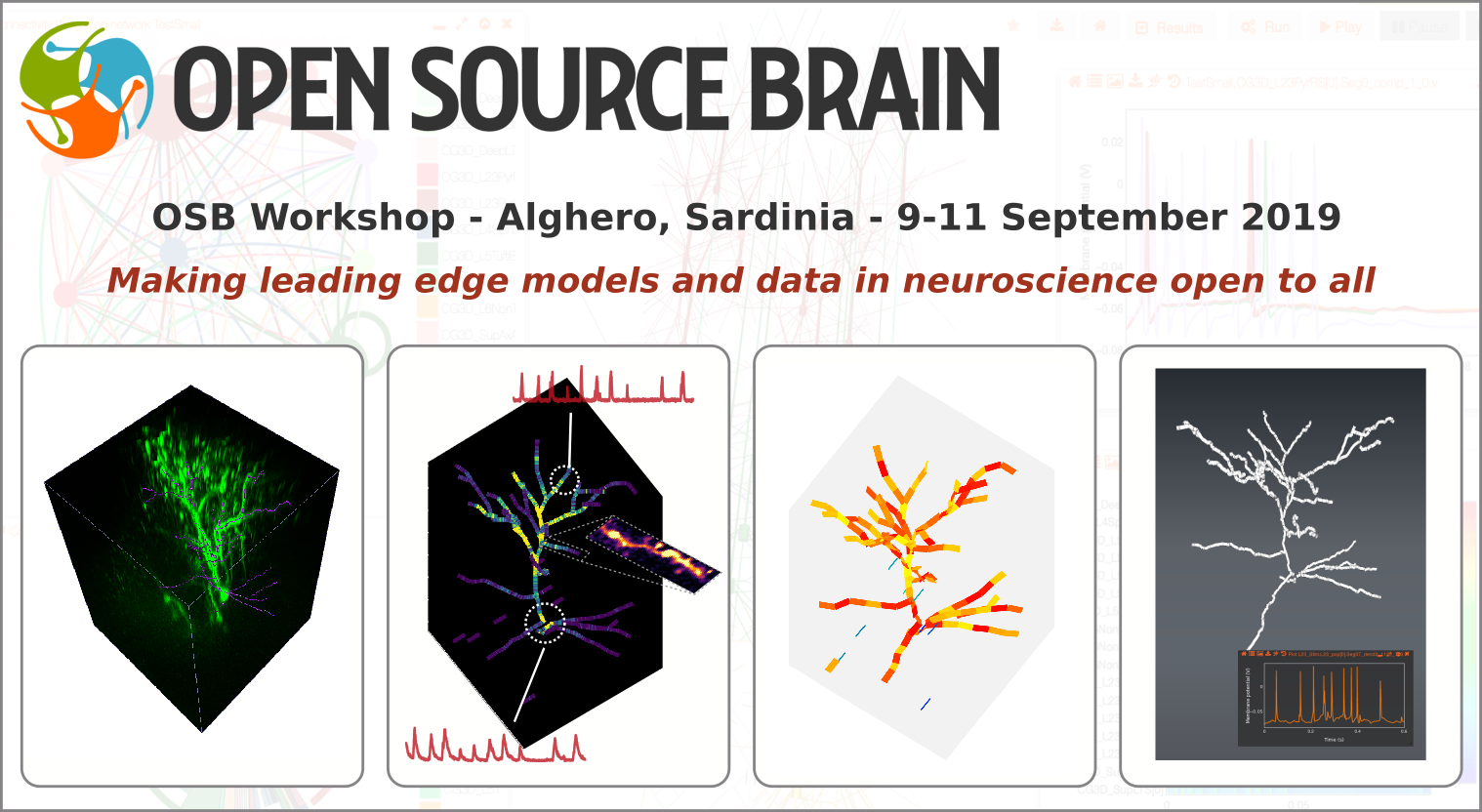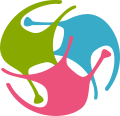OSB Meeting in Sardinia, 2019#

The OSB workshop 2019 took place in Alghero, Sardinia in September 2019.
Dates |
9am Monday 9th Sept. - 5pm Wednesday 11th Sept., 2019 |
|---|---|
Location |
Hotel Calabona, Alghero, Sardinia |
Organising committee |
Overview of the meeting#
Open Source Brain (http://www.opensourcebrain.org) was created as a platform for sharing and collaboratively developing models in computational neuroscience. Models of cells and circuits in standardised formats can be visualised, analysed and simulated through a standard web browser. The aim has been to improve the quality, accessibility and scientific rigour of models used to investigate brain function.
Following a renewal of our funding from the Wellcome Trust, we are expanding the functionality of the platform to also enable sharing of the experimental data behind the models. The OSB workshop 2019 highlighted the latest features of OSB and engaged current and future users of the platform through invited talks, hands on demonstrations, and user presentations.
The two key themes of the meeting were:
1) Accessible sharing of cellular neuroscience data
Through support for the Neurodata Without Borders (NWB) format, OSB will facilitate sharing of multiple types of experimental data used to constrain computational models, including electrophysiological recordings, Ca2+ florescence imaging, 2D, 3D and 4D imaging and behavioural data.
2) Modelling the cortex across scales
Cortical networks are modelled at many scales from abstract representations of interacting populations (neural masses) to networks of biophysically and morphologically detailed cell models. NeuroML is being expanded to cover a greater range of these models, which will allow them to be shared and simulated on OSB, facilitating comparison of models and ideas between researchers. This ongoing work is taking place as part of the SIG on Standardised Representations of Network Structures.
Agenda#
Mon 9th Sept Building and sharing standardised neuronal models#
Morning session
9:00 Angus Silver Welcome and Introduction to goals of meeting (Slides)
9:10 Padraig Gleeson Open Source Brain and NeuroML - Enabling collaborative model development in computational neuroscience (Slides)
9:50 Yann Zerlaut An overview of the tools for modelling and simulation developed within the Human Brain Project (Slides)
10:30 - 11:00 Coffee break
11:00 Sharon Crook NeuroML-DB: A model sharing platform to promote efficient model selection and reuse (Slides)
11:30 Rajnish Ranjan A kinetic map of the homomeric voltage-gated potassium channel (Kv) family
12:00 Boris Marin Converting models to NeuroML (Slides)
12:30 - 13:30 Lunch
Afternoon session
13:30 Matteo Cantarelli Geppetto: an open source platform to build neuroscience applications (Slides)
14:00 Ankur Sinha NeuroFedora: Free software for Open Science (Slides)
14:30 Lightning talks Bence András Lázár, Bettina Kata Kádár, Csaba Kazinczi (University of Szeged)
15:00 - 15:30 Coffee break
15:45 - 17:30 Discussion session: How do we make models more accessible and useful to scientists?
Are the current features of OSB (for sharing, visualization, analysis, simulation, tutorials and testing) sufficient for you to switch to using it in your model development and dissemination?
How can OSB better interact with other initiatives in the field, e.g. HBP/Allen?
How can we facilitate model conversion to populate OSB will all the key models available?
How can we lower the barrier for building new models and reusing existing components for new scientific questions?
What are the current limitations of NeuroML and PyNN?
Tues 10th Sept Standardising and sharing experimental neuroscience data#
Morning session
9:00 Angus Silver Introduction to session (Slides)
9:05 Diego Restrepo Shedding light on the involvement of the cerebellum in associative learning (Slides)
9:50 Simon Schultz NeuroSEE: a pipeline for processing and analysing data from multiphoton fluorescence brain imaging experiments (Slides)
10:35 - 11:00 Coffee break
11:00 Jeffrey S. Diamond The Blind Men and the Retina: Community Connectomics Prior to Automated Segmentation
11:45 Oliver Rübel NWB:N 2.0: An Ecosystem for Neurophysiology Data Standardization (Slides)
12:30 - 13:30 Lunch
Afternoon session
13:30 Matteo Cantarelli & Filippo Ledda NWB Explorer: visualize and understand neurophysiology data (Slides)
13:50 Ian Duguid Towards a systems level understanding of volitional motor control: approaches and challenges in data acquisition, management & sharing
14:35 Alex Cayco-Gajic (presented by Angus Silver) Population imaging and dimensionality analysis of cerebellar axons
15:00 - 15:30 Coffee break
15:30 - 17:00 Discussion session: How can we make data sharing accessible and useful?
What are the key challenges in standardizing data so that it can be parsed/reused?
Are the proposed solutions to data standardization appropriate for handling the size and heterogeneity of neuroscience data (e.g. behavioural analysis, high speed Ca2+ imaging, multi-channel electrophysiology, connectomics, genomics etc.)?
What are the key challenges in making data available?
What should be shared? Raw data, analysis, data points in figures?
Is sharing data worth the (considerable) effort - who will actually use it?
18:00 Bus to conference dinner Pedramare restaurant
Wed 11th Sept Investigating brain function across multiple scales#
Morning session
9:00 Angus Silver Introduction to session (Slides)
9:02 Jan Fousek The Virtual Brain: building blocks for whole-brain modeling (Slides)
9:45 Sacha van Albada Large-scale spiking neural network modeling of primate cerebral cortex (Slides)
10:30 - 11:00 Coffee break
11:00 Yazan Billeh Large-scale Datasets and Modeling Tools from the Allen Institute for Brain Science (Slides)
11:45 Fleur Zeldenrust Understanding information transfer in the brain: from single cell to network (Slides)
12:15 Sergio Solinas The NeuroAgents ERC project (Slides)
12:30 - 13:30 Lunch
Afternoon session
13:30 Oren Amsalem Cellular mechanisms of auditory surprise in faithful computer replica of cortical microcircuit
14:00 Padraig Gleeson Creating cortical models across scales in NeuroML (Slides)
14:30 - 15:00 Coffee break
15:30 - 17:30 Discussion session: How can we create better multiscale models of circuits?
Are multiscale models of the brain worth the effort?
What are the benefits of bringing multiscale models and the experimental data used to build and test them together?
What are the key challenges in linking model structure, optimization and testing to experimental data?
Do Python notebooks provide the right balance in the trade-off between accessibility and flexibility in model building/data analysis for OSB infrastructure?
Speakers#
Name |
Institution |
|---|---|
Oren Amsalem |
Hebrew University, Israel |
Yazan Billeh |
Allen Institute, USA |
Matteo Cantarelli |
MetaCell Ltd |
Alex Cayco Gajic |
University College London, UK & École Normale Supérieure, France |
Sharon Crook |
Arizona State University, USA |
Jeffrey S. Diamond |
NINDS, USA |
Ian Duguid |
University of Edinburgh, UK |
Matt Earnshaw |
University College London, UK |
Jan Fousek |
Aix Marseille Université, France |
Padraig Gleeson |
University College London, UK |
Boris Marin |
Universidade Federal do ABC, Brazil |
Rajnish Ranjan |
Blue Brain Project, EPFL, Switzerland |
Diego Restrepo |
University of Colorado, USA |
Oliver Rübel |
Lawrence Berkeley National Lab, USA |
Simon Schultz |
Imperial College, UK |
Angus Silver |
University College London, UK |
Ankur Sinha |
University of Hertfordshire, UK |
Sacha van Albada |
Jülich Research Centre, Germany |
Fleur Zeldenrust |
Radboud University, Netherlands |
Yann Zerlaut |
Centre National de la Recherche Scientifique, France |
Enquiries#
If you have any enquiries about this meeting, please don’t hesitate to contact: p.gleeson@ucl.ac.uk.
Support#
This meeting was generously supported by:
Data in image above courtesy of Antoine Valera, UCL

